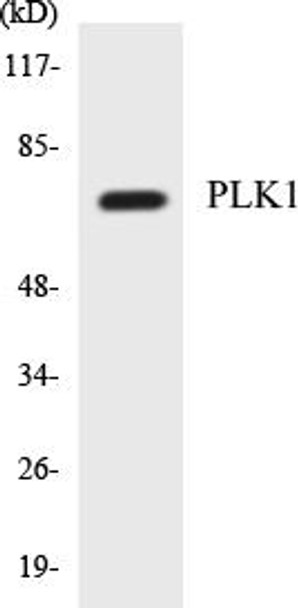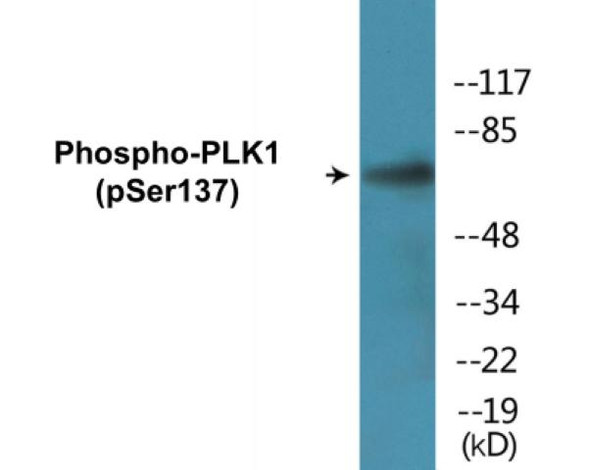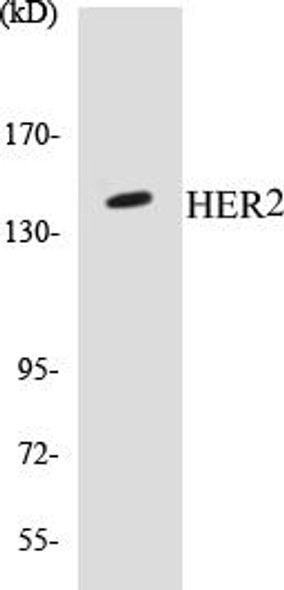Description
PLK1 Colorimetric Cell-Based ELISA Kit
The PLK1 (Polo-like kinase 1) Colorimetric Cell-Based ELISA Kit is a powerful tool for researchers looking to study the role of PLK1 in cell division and cancer development. This kit allows for the quantitative measurement of PLK1 levels in cell lysates, providing accurate and reliable results for a variety of experimental settings.PLK1 is a key regulator of cell cycle progression and is overexpressed in many cancer types, making it a promising target for cancer therapy.
By using this ELISA kit, researchers can gain valuable insights into the role of PLK1 in cancer biology and potentially identify new therapeutic strategies for treating cancer.With its high sensitivity and specificity, the PLK1 Colorimetric Cell-Based ELISA Kit is an essential tool for any researcher interested in studying the intricacies of cell division and cancer development. Get your kit today and unlock the potential of PLK1 research in your laboratory.
| Product Name: | PLK1 Colorimetric Cell-Based ELISA Kit |
| Product Code: | CBCAB00130 |
| ELISA Type: | Cell-Based |
| Target: | PLK1 |
| Reactivity: | Human, Mouse, Rat |
| Dynamic Range: | > 5000 Cells |
| Detection Method: | Colorimetric 450 nmStorage/Stability:4°C/6 Months |
| Format: | 96-Well Microplate |
The PLK1 Colorimetric Cell-Based ELISA Kit is a convenient, lysate-free, high throughput and sensitive assay kit that can detect PLK1 protein expression profile in cells. The kit can be used for measuring the relative amounts of PLK1 in cultured cells as well as screening for the effects that various treatments, inhibitors (ie siRNA or chemicals), or activators have on PLK1.
Qualitative determination of PLK1 concentration is achieved by an indirect ELISA format. In essence, PLK1 is captured by PLK1-specific primary antibodies while the HRP-conjugated secondary antibodies bind the Fc region of the primary antibody. Through this binding, the HRP enzyme conjugated to the secondary antibody can catalyze a colorimetric reaction upon substrate addition. Due to the qualitative nature of the Cell-Based ELISA, multiple normalization methods are needed:
| 1. | A monoclonal antibody specific for human GAPDH is included to serve as an internal positive control in normalizing the target absorbance values. |
| 2. | Following the colorimetric measurement of HRP activity via substrate addition, the Crystal Violet whole-cell staining method may be used to determine cell density. After staining, the results can be analysed by normalizing the absorbance values to cell amounts, by which the plating difference can be adjusted. |
| Database Information: | Gene ID: 5347, UniProt ID: P53350, OMIM: 602098, Unigene: Hs.592049 |
| Gene Symbol: | PLK1 |
| Sub Type: | None |
| UniProt Protein Function: | PLK1: a kinase of the PLK family. Contains a polo-box domain (PBD), a specific phosphoserine or phosphothreonine binding domain. Substrates include BRCA2, Myt1, NudC, Cdc25C, cyclin B1, Nlp and other mitotic proteins. Inhibited by ATR. Plays a role in regulation of cytokinesis and coordinating M-phase events. |
| UniProt Protein Details: | Protein type:EC 2.7.11.21; Protein kinase, Ser/Thr (non-receptor); Kinase, protein; Protein kinase, Other; Other group; PLK family Chromosomal Location of Human Ortholog: 16p12.2 Cellular Component: spindle pole; centrosome; cytosol; kinetochore; microtubule cytoskeleton; nucleoplasm; spindle microtubule; cytoplasm; nucleolus; spindle; midbody; spindle midzone; nucleus Molecular Function:protein serine/threonine kinase activity; protein binding; microtubule binding; kinase activity; protein kinase binding; ATP binding; protein kinase activity Biological Process: positive regulation of ubiquitin-protein ligase activity during mitotic cell cycle; positive regulation of proteolysis; regulation of cell cycle; regulation of mitotic cell cycle; mitotic nuclear envelope disassembly; protein ubiquitination; anaphase-promoting complex activation during mitotic cell cycle; cytokinesis; negative regulation of transcription from RNA polymerase II promoter; protein amino acid phosphorylation; response to antibiotic; establishment of protein localization; cytokinesis after mitosis; centrosome organization and biogenesis; anaphase-promoting complex-dependent proteasomal ubiquitin-dependent protein catabolic process; positive regulation of ubiquitin-protein ligase activity; mitotic cell cycle spindle assembly checkpoint; G2/M transition of mitotic cell cycle; mitosis; protein destabilization; mitotic sister chromatid segregation; organelle organization and biogenesis; regulation of mitotic metaphase/anaphase transition; negative regulation of cyclin-dependent protein kinase activity; cell proliferation; peptidyl-serine phosphorylation; regulation of ubiquitin-protein ligase activity during mitotic cell cycle; regulation of protein binding; positive regulation of proteasomal ubiquitin-dependent protein catabolic process; polar body extrusion after meiotic divisions; mitotic cell cycle; G2/M transition DNA damage checkpoint; microtubule bundle formation; mitotic metaphase/anaphase transition; negative regulation of apoptosis |
| NCBI Summary: | The Ser/Thr protein kinase encoded by this gene belongs to the CDC5/Polo subfamily. It is highly expressed during mitosis and elevated levels are found in many different types of cancer. Depletion of this protein in cancer cells dramatically inhibited cell proliferation and induced apoptosis; hence, it is a target for cancer therapy. [provided by RefSeq, Sep 2015] |
| UniProt Code: | P53350 |
| NCBI GenInfo Identifier: | 1709658 |
| NCBI Gene ID: | 5347 |
| NCBI Accession: | P53350.1 |
| UniProt Secondary Accession: | P53350,Q15153, Q99746, |
| UniProt Related Accession: | P53350 |
| Molecular Weight: | 68,255 Da |
| NCBI Full Name: | Serine/threonine-protein kinase PLK1 |
| NCBI Synonym Full Names: | polo-like kinase 1 |
| NCBI Official Symbol: | PLK1 |
| NCBI Official Synonym Symbols: | PLK; STPK13 |
| NCBI Protein Information: | serine/threonine-protein kinase PLK1; PLK-1; polo like kinase; polo (Drosophia)-like kinase; serine/threonine-protein kinase 13; cell cycle regulated protein kinase |
| UniProt Protein Name: | Serine/threonine-protein kinase PLK1 |
| UniProt Synonym Protein Names: | Polo-like kinase 1; PLK-1; Serine/threonine-protein kinase 13 |
| Protein Family: | Phosphoadenosine phosphosulfate reductase |
| UniProt Gene Name: | PLK1 |
| UniProt Entry Name: | PLK1_HUMAN |
| Component | Quantity |
| 96-Well Cell Culture Clear-Bottom Microplate | 2 plates |
| 10X TBS | 24 mL |
| Quenching Buffer | 24 mL |
| Blocking Buffer | 50 mL |
| 15X Wash Buffer | 50 mL |
| Primary Antibody Diluent | 12 mL |
| 100x Anti-Phospho Target Antibody | 60 µL |
| 100x Anti-Target Antibody | 60 µL |
| Anti-GAPDH Antibody | 60 µL |
| HRP-Conjugated Anti-Rabbit IgG Antibody | 12 mL |
| HRP-Conjugated Anti-Mouse IgG Antibody | 12 mL |
| SDS Solution | 12 mL |
| Stop Solution | 24 mL |
| Ready-to-Use Substrate | 12 mL |
| Crystal Violet Solution | 12 mL |
| Adhesive Plate Seals | 2 seals |
The following materials and/or equipment are NOT provided in this kit but are necessary to successfully conduct the experiment:
- Microplate reader able to measure absorbance at 450 nm and/or 595 nm for Crystal Violet Cell Staining (Optional)
- Micropipettes with capability of measuring volumes ranging from 1 µL to 1 ml
- 37% formaldehyde (Sigma Cat# F-8775) or formaldehyde from other sources
- Squirt bottle, manifold dispenser, multichannel pipette reservoir or automated microplate washer
- Graph paper or computer software capable of generating or displaying logarithmic functions
- Absorbent papers or vacuum aspirator
- Test tubes or microfuge tubes capable of storing ≥1 ml
- Poly-L-Lysine (Sigma Cat# P4832 for suspension cells)
- Orbital shaker (optional)
- Deionized or sterile water
*Note: Protocols are specific to each batch/lot. For the correct instructions please follow the protocol included in your kit.
| Step | Procedure |
| 1. | Seed 200 µL of 20,000 adherent cells in culture medium in each well of a 96-well plate. The plates included in the kit are sterile and treated for cell culture. For suspension cells and loosely attached cells, coat the plates with 100 µL of 10 µg/ml Poly-L-Lysine (not included) to each well of a 96-well plate for 30 minutes at 37°C prior to adding cells. |
| 2. | Incubate the cells for overnight at 37°C, 5% CO2. |
| 3. | Treat the cells as desired. |
| 4. | Remove the cell culture medium and rinse with 200 µL of 1x TBS, twice. |
| 5. | Fix the cells by incubating with 100 µL of Fixing Solution for 20 minutes at room temperature. The 4% formaldehyde is used for adherent cells and 8% formaldehyde is used for suspension cells and loosely attached cells. |
| 6. | Remove the Fixing Solution and wash the plate 3 times with 200 µL 1x Wash Buffer for five minutes each time with gentle shaking on the orbital shaker. The plate can be stored at 4°C for a week. |
| 7. | Add 100 µL of Quenching Buffer and incubate for 20 minutes at room temperature. |
| 8. | Wash the plate 3 times with 1x Wash Buffer for 5 minutes each time. |
| 9. | Add 200 µL of Blocking Buffer and incubate for 1 hour at room temperature. |
| 10. | Wash 3 times with 200 µL of 1x Wash Buffer for 5 minutes each time. |
| 11. | Add 50 µL of 1x primary antibodies (Anti-PLK1 Antibody and/or Anti-GAPDH Antibody) to the corresponding wells, cover with Parafilm and incubate for 16 hours (overnight) at 4°C. If the target expression is known to be high, incubate for 2 hours at room temperature. |
| 12. | Wash 3 times with 200 µL of 1x Wash Buffer for 5 minutes each time. |
| 13. | Add 50 µL of 1x secondary antibodies (HRP-Conjugated AntiRabbit IgG Antibody or HRP-Conjugated Anti-Mouse IgG Antibody) to corresponding wells and incubate for 1.5 hours at room temperature. |
| 14. | Wash 3 times with 200 µL of 1x Wash Buffer for 5 minutes each time. |
| 15. | Add 50 µL of Ready-to-Use Substrate to each well and incubate for 30 minutes at room temperature in the dark. |
| 16. | Add 50 µL of Stop Solution to each well and read OD at 450 nm immediately using the microplate reader. |
(Additional Crystal Violet staining may be performed if desired – details of this may be found in the kit technical manual.)






